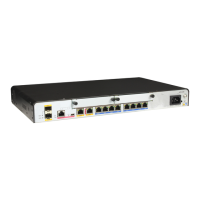3.1 WLAN QoS Overview
The WLAN QoS feature provides services of different qualities for WLAN users.
An 802.11 network provides the competition-based wireless access service. Different
applications have different requirements for networks; however, traditional networks cannot
provide access services of different qualities for different applications.
IEEE 802.11e defines the QoS feature for the 802.11-based WLAN system. The Wi-Fi Alliance
defines the Wi-Fi Multimedia (WMM) standard for communication between QoS-supported
devices of different WLAN vendors. WMM enables a WLAN network to provide QoS features.
WMM
WMM provides QoS features for 802.11 networks and enables high-priority packets to be sent
first. This provides better quality for voice and video services on WLANs.
EDCA
Enhanced Distributed Channel Access (EDCA) is a channel preemption mechanism defined by
WMM, enabling high-priority packets to be sent first and allocated more bandwidth.
AC
WMM prioritizes queues of four access categories (ACs) in descending order: AC-voice (AC-
VO), AC-video (AC-VI), AC-best effort (AC-BE), and AC-background (AC-BK). This ensures
that packets in a high-priority queue have greater capabilities in channel preemption.
3.2 WLAN QoS Features Supported by the AR1200
The AR1200 supports radio QoS policy management, VAP QoS policy management.
Radio QoS Policy Management
In the 802.11 protocol, the distributed coordination function (DCF) defines the Carrier Sense
Multiple Access with Collision Avoidance (CSMA/CA) access mechanism for APs and STAs.
Before occupying a channel to send packets, APs or STAs monitor the channel. If the channel
idle time is longer than or equal to the arbitration inter frame spacing number (AIFSN), each
AP or STA selects a random backoff time between exponent form of minimum contention
window (ECWmin) and exponent form of maximum contention window (ECWmax). The first
AP or STA whose backoff timer expires occupies the channel and starts to send packets over
the channel.
WMM provides four AC queues: AC-VO for voice service flows, AC-VI for video service flows,
AC-BE for best effort flows, and AC-BK for common data flows. Packets in a high-priority AC
queue have greater capabilities in channel preemption. A set of EDCA parameters is set for each
AC queue. These parameters determine the capabilities of queues in channel preemption.
EDCA parameters are as follows:
l AIFSN: determines the channel idle time. A greater AIFSN value indicates a longer channel
idle time.
Huawei AR1200 Series Enterprise Routers
Configuration Guide - WLAN 3 WLAN QoS Configuration
Issue 03 (2012-01-06) Huawei Proprietary and Confidential
Copyright © Huawei Technologies Co., Ltd.
41

